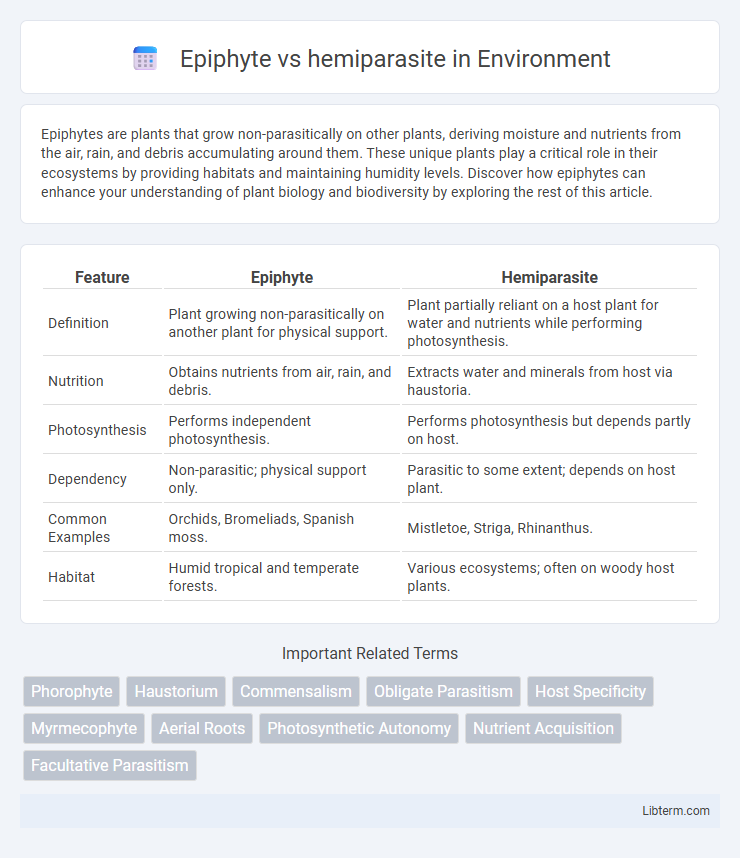Epiphytes are plants that grow non-parasitically on other plants, deriving moisture and nutrients from the air, rain, and debris accumulating around them. These unique plants play a critical role in their ecosystems by providing habitats and maintaining humidity levels. Discover how epiphytes can enhance your understanding of plant biology and biodiversity by exploring the rest of this article.
Table of Comparison
| Feature | Epiphyte | Hemiparasite |
|---|---|---|
| Definition | Plant growing non-parasitically on another plant for physical support. | Plant partially reliant on a host plant for water and nutrients while performing photosynthesis. |
| Nutrition | Obtains nutrients from air, rain, and debris. | Extracts water and minerals from host via haustoria. |
| Photosynthesis | Performs independent photosynthesis. | Performs photosynthesis but depends partly on host. |
| Dependency | Non-parasitic; physical support only. | Parasitic to some extent; depends on host plant. |
| Common Examples | Orchids, Bromeliads, Spanish moss. | Mistletoe, Striga, Rhinanthus. |
| Habitat | Humid tropical and temperate forests. | Various ecosystems; often on woody host plants. |
Introduction to Epiphytes and Hemiparasites
Epiphytes are non-parasitic plants that grow on other plants primarily for physical support, deriving moisture and nutrients from the air, rain, and debris around them, common in tropical rainforests such as orchids and bromeliads. Hemiparasites are partially parasitic plants capable of photosynthesis but rely on host plants for water and nutrients, typically attaching to roots or stems, examples include mistletoe and some species of sandalwood. Both epiphytes and hemiparasites exhibit specialized adaptations for survival in unique ecological niches, influencing their relationships with host plants and surrounding environments.
Defining Epiphytes: Characteristics and Adaptations
Epiphytes are non-parasitic plants that grow on other plants, primarily trees, without extracting nutrients from their hosts. They possess specialized adaptations such as aerial roots, water-absorbing trichomes, and the ability to capture moisture from the air to survive in nutrient-poor environments. Unlike hemiparasites, epiphytes rely entirely on photosynthesis and ambient resources rather than tapping into the vascular system of their host plants.
Understanding Hemiparasites: Features and Survival Strategies
Hemiparasites possess specialized structures called haustoria that penetrate host plants to extract water and nutrients while retaining the ability to photosynthesize, distinguishing them from epiphytes which rely solely on their host for physical support. These plants exhibit a mixotrophic survival strategy, combining autotrophic photosynthesis with heterotrophic nutrient acquisition, enabling them to thrive in nutrient-poor environments. Common examples such as mistletoe highlight hemiparasites' capacity to balance independence and dependency, optimizing resource use and ecological adaptability.
Habitat Preferences and Distribution
Epiphytes primarily thrive in humid tropical and subtropical forests, growing on trees without drawing nutrients from their hosts, which allows them to occupy aerial habitats and access filtered sunlight. Hemiparasites are commonly found in diverse ecosystems, including temperate and tropical regions, where they attach to host plants' roots or stems to extract water and nutrients while performing photosynthesis independently. Distribution patterns of epiphytes correlate strongly with high humidity and canopy structure, whereas hemiparasite distribution aligns with the availability of suitable host species and soil types.
Nutritional Strategies: Differences in Resource Acquisition
Epiphytes obtain nutrients and moisture primarily from the air, rain, and debris accumulating around their roots, relying on non-parasitic strategies for survival. Hemiparasites derive water and minerals directly from host plants through specialized structures called haustoria while still performing photosynthesis to produce their own carbohydrates. This fundamental difference in resource acquisition underlines epiphytes' independence from host plants compared to the partial dependency characteristic of hemiparasites.
Impact on Host Plants and Ecosystems
Epiphytes grow non-parasitically on host plants, primarily using them for physical support without extracting nutrients, thus having minimal direct impact on host plant health and often enhancing local biodiversity by providing habitats. Hemiparasites partially rely on host plants for water and nutrients via specialized structures called haustoria, which can weaken host plants by reducing their vigor and growth, sometimes altering community dynamics and nutrient cycles. The ecological roles of epiphytes and hemiparasites differ significantly, with epiphytes contributing to habitat complexity and microclimate regulation, while hemiparasites influence host population structure and ecosystem nutrient redistribution.
Morphological Differences between Epiphytes and Hemiparasites
Epiphytes possess specialized root structures adapted for anchoring on host plants without penetrating their tissues, relying primarily on aerial roots for water and nutrient absorption from the environment. Hemiparasites exhibit haustoria, specialized organs that penetrate host tissues to extract water and nutrients while maintaining photosynthetic ability. Morphologically, epiphytes have adaptations for nutrient uptake from rain, debris, and air, whereas hemiparasites show anatomical modifications to form direct parasitic connections with host vascular systems.
Common Examples of Epiphytes and Hemiparasites
Common examples of epiphytes include orchids, bromeliads, and ferns, which thrive on tree branches by absorbing moisture and nutrients from the air and rain. Hemiparasites such as mistletoe, Indian paintbrush, and dodder partially rely on host plants for water and nutrients while still performing photosynthesis independently. Both groups adapt uniquely to their environments, with epiphytes mostly nonparasitic and hemiparasites exhibiting partial parasitism.
Ecological Roles and Benefits
Epiphytes contribute to ecosystems by providing habitat and moisture retention on host plants without extracting nutrients, supporting biodiversity and microhabitats in forest canopies. Hemiparasites, such as mistletoe, play a complex ecological role by partially extracting water and nutrients from host plants, which can influence plant community dynamics and enhance soil nutrient cycling through leaf litter. Both epiphytes and hemiparasites increase habitat heterogeneity, fostering diverse animal communities and promoting ecosystem resilience.
Conclusion: Key Distinctions and Significance
Epiphytes obtain moisture and nutrients primarily from the air and debris, growing non-parasitically on host plants without harming them, whereas hemiparasites partially rely on their hosts for water and nutrients through specialized structures called haustoria. Understanding these distinctions is crucial for ecological studies, as epiphytes contribute to biodiversity and habitat complexity while hemiparasites influence host health and nutrient cycling. Recognizing their different ecological roles aids in conservation efforts and ecosystem management strategies.
Epiphyte Infographic

 libterm.com
libterm.com